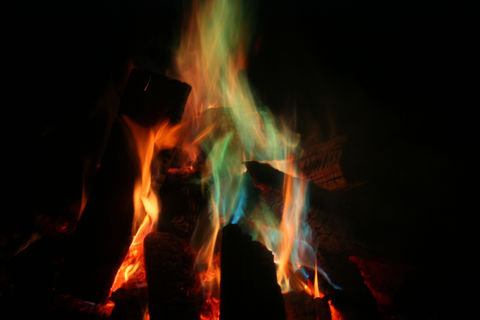Blog Post
Pete’s Puzzle: Fanciful Fuel
The support column for this home's fireplace is made of concrete blocks (CMUs). What caused the unusual blue-green stains?
But there was a puzzling stain on the fireplace support column. Here are the puzzle pieces:
Puzzle Piece #1:
The client is certain that the blue-green staining on the CMU column built to support the massive fireplace in the living room predates their switch to a woodstove insert in the fireplace.
Puzzle Piece #2:
SUPPORT INDEPENDENT SUSTAINABILITY REPORTING
BuildingGreen relies on our premium members, not on advertisers. Help make our work possible.
See membership options »The woodstove insert in the fireplace.
It sure looked to me as though the blue-green stain was a sort of efflorescence caused by water wicking up the CMUs and carrying some sort of salt with it. But where is the water that is wicking coming from?
Puzzle Piece #3:
I always start by considering bulk water, so I thought: maybe the chimney is not capped and enough bulk water is coming down the chimney to feed the wicking. Darn — a quick check outside reveals a staunch chimney cap (see Image #5, below). Could be that this is a problem that predates the chimney cap?
Puzzle Piece #4:
The next place I always look for water is from capillary continuity with soil moisture; maybe there is no moisture barrier underneath the concrete basement slab. Before drilling a hole in the slab somewhere, I discovered a slab hole for what used to be a functioning sump. I reached down and felt a heavy plastic sheet just beneath the 4-inch concrete slab.
Puzzle Piece #5:
Stumped. It's got to be either bulk water coming down or wicking water coming up; but how can there be soil moisture moving up into the blocks of the column when the basement slab has a moisture barrier underneath it?
When would the CMU column get built? At the same time as the perimeter walls of the foundation. Is the CMU support column on a separate footing? And was the CMU work done before the slab flatwork? You got it; it's very likely that the moisture barrier under the slab is continuous except under the CMU fireplace column.
OK, so now we are pretty sure about the moisture source. But what about the blue-green efflorescence? Efflorescence from salts in the mortar or block is always white, not this striking blue-green. Metallic salts like copper chloride, potassium chlorate, and lithium carbonate “burn” with blue, green, and reddish hues.
Puzzle Piece #6:
I remember from high school chemistry that nearly all copper salts are blue or green, so a good guess is that some source of copper is inside that CMU column (or maybe from the soil below).
Remember that the blue-green staining pretty much follows the mound of the ash… So is the source of the copper salts related to what they were burning in the fireplace?
Maybe they were burning pressure-treated lumber in the fireplace; that contains copper salts, right? I sure hope not! What else would someone burn with a lot of metallic salts in it? (Remember the title: “Fanciful Fuel”?)
I can’t prove that this is the answer, because we don’t know enough about the prior occupants, but I am convinced that they spent a lot of time staring into a beautiful and colorful log fire…
Metallic salts like copper chloride, potassium chlorate, and lithium carbonate “burn” with blue, green, and reddish hues. These chemicals can be found in commercial products like Mystical Fire.
The solution?
Drain-to-daylight pipes for the foundation perimeter drainage system.
- Clean out the bottom ash, scrub off the blue-green efflorescence, and wait a bit before priming and painting the block, just to be sure the problem is licked.
- Confirm that the footing perimeter drainage system is working, that it is relieving any moisture pressure around the foundation (I located the drain-to-daylight for the foundation perimeter drainage system).
- Seal the above-grade portion of the CMU foundation system so it is not taking on splash-back moisture.
Published May 2, 2017 Permalink Citation
Yost, P. (2017, May 2). Pete’s Puzzle: Fanciful Fuel. Retrieved from https://www.buildinggreen.com/blog/pete-s-puzzle-fanciful-fuel



Add new comment
To post a comment, you need to register for a BuildingGreen Basic membership (free) or login to your existing profile.